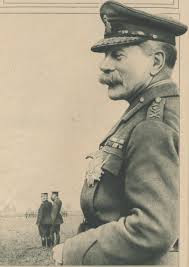 |
| Poppies and woods - enduring symbols of the Battle of the Somme |
Right up to the deadline the bombardment continued, allowing the men to gather in their trenches and in the multiple saps built out into No Man's Land. The intention was that at 7.28 the ten mines (three of them enormous) constructed beneath the German front, would be blown, allowing two minutes for the debris to settle and give the infantrymen a head start in their march to the first line objectives. There was one exception to this, the Hawthorn Ridge mine just west of Beaucourt-Hamel. One of the three biggest mines, this was detonated at 7.20am at the request of the on site Corps Commander, Aylmer Hunter-Weston (of Gallipoli fame / infamy, see 24/4/15), who wanted his men to take control of the crater before the 7.30 whistle. The enormous explosion was captured on film and makes one of the best known and enduring images of the war, but did little more than give added warning to the Germans of the coming attack. At 7.28 the other mines went off on schedule, including the other two giant explosions on either side of the main Albert-Bapaume road.
Then at 7.30 precisely the whistles blew all along the line, and 60,000 troops began to go over the top, led by their platoon and company commanders.
The Somme has been described as a battle of 141 days in two parts - the 1st July and the remaining 140 days. What follows is a very brief summary of that first day.
In broad terms, there were four sectors to the front. The northernmost was the Gommecourt salient, where Allenby's VII Corps were to make their diversionary assault; then the northern sector on either side of the Ancre valley including Serre, Beaucourt-Hamel and Thiepval; the central assault either side of the Albert-Bapaume road where German positions centred on the fortified villages of Ovillers and La Boiselle; and the southernmost sector where the line of the front turned east at Fricourt, through Mametz and Montauban to the junction with the French forces at Maricourt.
At Gommecourt the somewhat reluctant commander of VII corps of Allenby's 3rd Army, Snow, launched his two Divisions in a pincer attack around Gommecourt village and its associated Chateau woods. The 46th Division of East Midlanders ran into fierce opposition on the northern front and barely made progress to the wood on the edge of the village. To the south, the 56th Division of Londoners made significant early gains but, unable to link with their northern flank, were gradually pushed back with large numbers killed or captured. Overall the attack, although it engaged the local German defenders and prevented them moving elsewhere, was a costly failure.
 |
| Serre Road Cemetery. |
At the Northern end of Rawlinson's 4th Army, Hunter-Weston's VIII corps had three divisions, including the now renowned 29th Division. (This had initially been the Royal Naval Division, whose war started with the desperate defence of Antwerp in 1914 and was followed by Gallipoli throughout 1915). As at Gallipoli they, and fellow Divisions 31st and 4th of VIII Corps were thrown at withering machine gun fire placed in advantageous positions. Artillery preparation had had limited effects here, and there was much uncut barbed wire, funnelling troops into the few gaps. The 31st Division contained many Pals battalions from Yorkshire and Lancashire. The Sheffield Memorial park pictured below is a sombre memorial to the bravery and sacrifice of those men, many of whom had marched through soggy ground until just 4 hours before deadline, and whose involvement lasted seconds or minutes. Desperate stuff. To their south the more experienced 4th Division did little better south of Serre. At Beaumont Hamel the doughty 29th Division flung themselves unavailingly at the German defences. The Newfoundlanders Brigade was almost obliterated, suffering 91% casualties.
The attack of the 36th Division across the Ancre valley on the higher ground of Thiepval had an initial success with the capture of the Schwaben redoubt. Strangely, this isolated good news found its way back to HQ, and was taken as indicative of more general success. Further progress was not possible against fierce counter-attacks and by the nightfall the Germans had recaptured the redoubt, despite the heroic efforts of the Ulster Brigades of the 36th Division, which have passed into legend
 |
| Sheffield Memorial Park. A poignant symbol of the decimated communities created by the 'Pals' battalion structure. |
It was to the east of Fricourt that the Mametz and Montauban village objectives were taken with speed and relative ease by the 7th, 18th and 30th Divisions. Some important boost to the pre-bombardment was given by French artillery, which had a greater weight of shot. With hindsight we know that the Germans were weaker here, and there might even have been the opportunity for a Cavalry break through the deeper lines. However, by mid afternoon Rawlinson had decided the Cavalry was going nowhere and he stood them down.
The French forces straddled the river Somme itself, very marshy ground. They had limited objectives for Day 1, which they attained with ease, and like the British in this sector did not push further.
That evening in a meeting with Haig and the French Sector commander Foch, Rawlinson had to concede that matters had not run well, but he was unaware of the scale of the disaster. He estimated casualties at less than one third of their true figure (15,000 vs 57,000). Across No Man's Land thousands of dead, dying and wounded were strewn, and their mates ventured out in small parties to try and recover them at the end of a truly terrible day.













